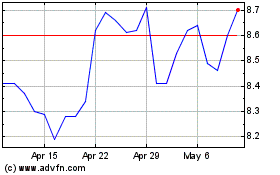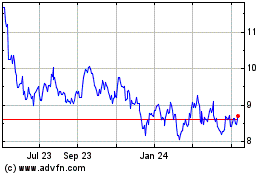Samsung Electronics Co. is facing growing consumer confusion and
anger as the world's biggest smartphone maker grapples with a
recall of its newest devices following reports of exploding
batteries.
The South Korean technology company said early this month that
it is recalling 2.5 million Galaxy Note 7 large-screen smartphones
in 10 countries and other markets where the device had been
shipped, citing faulty batteries that have led to some exploding
while charging. Some 11 days later, the South Korean company had
yet to set a specific timeline in important markets such as the
U.S. and Canada on when consumers can get a replacement phone.
The company is also grappling with the issue of whether it will
have enough supply of the new phones and components to replace
millions of handsets that have reached consumers in such a short
time frame.
Since Samsung announced the recall on Sept. 2, more than $10
billion has been wiped off the company's market value. Samsung also
has delayed launches in other crucial markets such as India, and
suffered dwindling consumer confidence as airlines and the U.S.
Consumer Product Safety Commission have warned against people using
or charging the phone on planes.
Samsung's decision to recall the phones from consumers in
different countries through different exchange programs has proved
to be a bigger-than-expected challenge, and harder than a
simultaneous global recall, people familiar with the matter
said.
"This is not an issue that can be fixed overnight," a
spokeswoman for Samsung said Tuesday, when asked how the recalls
were proceeding in the different markets. "Recalls are conducted
based on the situation in each country and after consultations with
different partners and carrier companies," she said.
It is difficult to predict when consumers can have their phones
replaced, she said, adding that Samsung is working to meet the
demands as soon as possible.
She said in markets such as the U.S. and Canada, replacement
phones would be provided after an investigation by safety
regulators in those countries.
In the U.S., some consumers have resisted returning their phones
and are blaming phone carriers and retailers for confusion about
how the phone swap works.
"Everybody is in a little bit of a standstill," said a person
working for a major U.S. carrier with knowledge of Samsung's recall
effort.
Olivier Cassagnol, a lawyer in New York, is using his Note 7,
despite the warnings, because he says a Samsung customer
representative said it could be possible to replace his phone with
another Note 7.
"Of course, I'm nervous that I might have a defective unit, so I
want to either have it confirmed my phone is fine or replace the
unit," he said.
Samsung acknowledged Note 7 holdouts remain. "We encourage all
Note 7 owners who have not yet done so, to exchange their phones
today," a Samsung spokeswoman said.
The consumer confusion stems from the fact that Samsung's recall
wasn't conducted through the CPSC, the way recalls in the U.S. are
legally supposed to occur.
Once the CPSC issues a recall, it typically becomes illegal to
sell or resell the affected product until it is repaired.
Samsung and the CPSC have said they are coordinating their
efforts now. An official recall could clear up confusing messages
to consumers.
"Samsung is at risk of turning a minor drama into a major
crisis. Samsung needs to get a decisive grip of the battery problem
and fix it," said Neil Mawston, an analyst at Strategy Analytics.
"Apple has been gifted an unexpected opportunity to benefit from
Samsung's product missteps in the coming holiday season."
On Tuesday, shares in Samsung recovered to close up 4.2% after
two consecutive sessions of losses. Analysts said the rebound came
after Samsung's decision to sell noncore assets and the nomination
of heir apparent Lee Jae-yong as a board member, a move analysts
say is likely to speed up decision-making at the company.
The prospect of a prolonged process means Samsung has lost a
crucial window of opportunity to sway consumers to its new phones
after it got the jump on rival Apple Inc. by launching the new
models in August. The iris-scanning Galaxy Note 7, which costs more
than $800 in the U.S, garnered rave reviews before Apple, the
world's most profitable smartphone seller, unveiled its iPhone 7
last week.
It comes at a critical juncture for Samsung, with the Galaxy
Note 7 and flagship Galaxy S7 having signaled a possible reversal
of the company's fortunes from a bruising two years of profit
declines. The Galaxy Note 7 has been pulled from shelves from
Australia to the U.S., which will likely hit Samsung's sales in the
crucial second half of the year in an industry grappling with
slowing demand and razor-thin margins.
Samsung plans to begin its exchange program in Singapore on
Friday. Consumers will be allowed to return their phones through
retailers, carriers and shops, and receive new devices. The company
intends to expand the program to Australia, Mexico, South Korea,
Taiwan and the United Arab Emirates later this month.
On Tuesday, Samsung said it would pull television advertising in
South Korea for the Galaxy Note 7 and place ads in newspapers
apologizing for the recall.
But the moves might be too slow to prevent bigger damage. Some
consumers have already begun shifting to rival phone makers.
Samsung hasn't revealed details of the problem involving the
lithium-ion batteries supplied by affiliate Samsung SDI Co., other
than to say a flaw resulted from an error in the manufacturing
process.
"Samsung may be compensating its users with the recall, but it
hasn't regained customers' trust. The Galaxy Note 7's safety is
still doubtful," said 31-year-old Seoul resident Park Seung-shin,
who likes to change his smartphone every one to two years. He said
he is thinking of getting the new iPhone 7.
In downtown Sydney a Vodafone store employee said Tuesday that
about 20 Galaxy Note 7 buyers a day initially had turned in their
phones when the recall was announced, though that number was
tapering off. Some left the store with an iPhone instead of waiting
for a replacement Samsung smartphone to be shipped, the employee
said.
Samsung previously said it recalled about 51,000 phones in
Australia. On Tuesday, a company spokeswoman said customers who
wanted a replacement phone in Australia would be contacted starting
Sept. 21 about getting a new device.
In China, where the phone hasn't been recalled because Samsung
uses a different battery supplier there, rival Chinese vendors are
prepping for new phone launches later in the fall. Chinese
smartphone maker, Huawei Technologies Co., which aims to overtake
Samsung globally in smartphone sales within the next five years, is
preparing to introduce a new high-end phone later this year.
Earlier this month, Samsung's handset division chief, Koh
Dong-jin, said the company might seek a third supplier beyond the
two existing battery suppliers—Samsung SDI and Hong Kong-based
Amperex Technology Ltd.—to meet demand. Samsung declined to comment
Tuesday when asked who the third battery supplier might be.
Analysts expect Samsung to be able to deal with the recall's
financial burden, which is estimated to be $1 billion, given the
company's hefty cash reserve of $23 billion.
Samsung is raising cash by selling noncore assets. On Monday, it
announced plans to sell its printer business to HP Inc. for more
than $1 billion. Strong demand for Samsung's chip and display
businesses—which also end up in rivals' smartphones—could help
cushion the recall's impact, analysts said.
Eva Dou, Mike Cherney, John McKinnon and Nathan Olivarez-Giles
contributed to this article.
Write to Eun-Young Jeong at Eun-Young.Jeong@wsj.com, Georgia
Wells at Georgia.Wells@wsj.com and Yun-Hee Kim at
yun-hee.kim@wsj.com
(END) Dow Jones Newswires
September 14, 2016 08:05 ET (12:05 GMT)
Copyright (c) 2016 Dow Jones & Company, Inc.
Vodafone (NASDAQ:VOD)
Historical Stock Chart
From Mar 2024 to Apr 2024

Vodafone (NASDAQ:VOD)
Historical Stock Chart
From Apr 2023 to Apr 2024
